Lethargic Chickens: 14 Reasons Why Your Chicken Seems Depressed
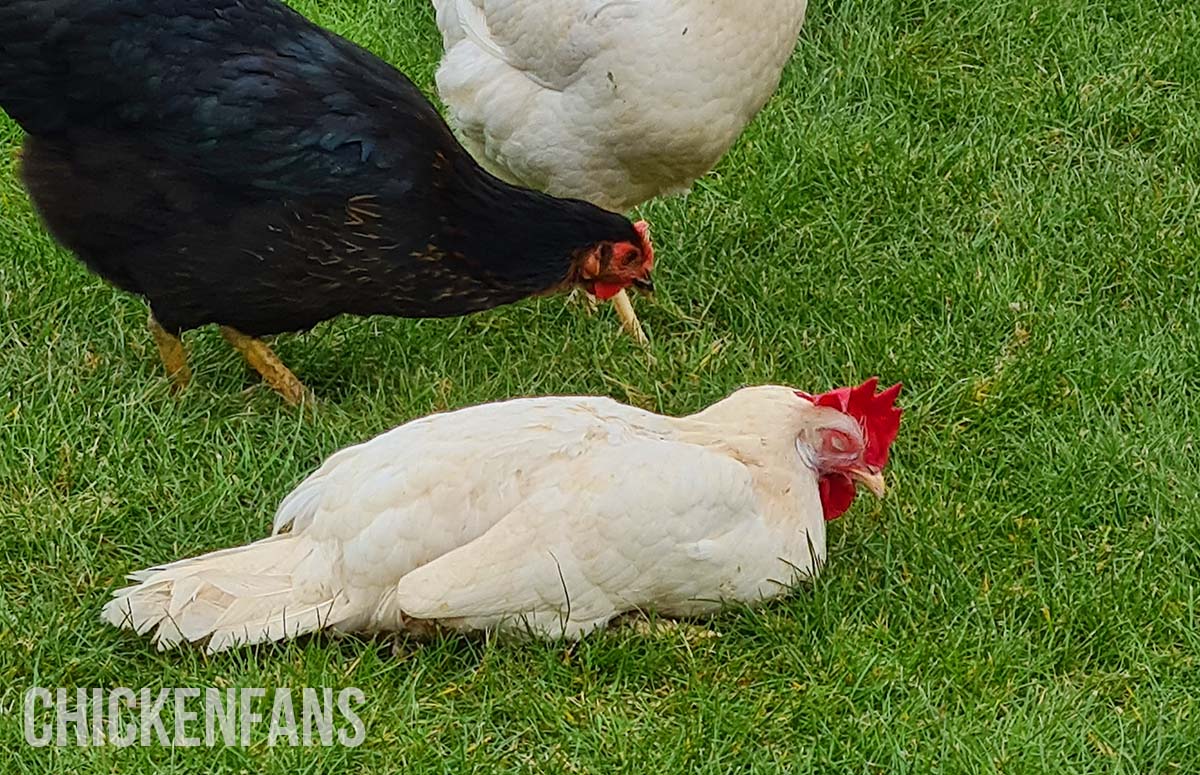
Lethargy is a common symptom in chickens that should be taken seriously. If your chicken is lounging on the ground with its eyes closed, ready to nap, it could be a red flag signaling an underlying health issue.
We’ll go over the most common causes of depression, listlessness, and lethargy in chickens one by one and discuss how to treat your birds:
- Chronic Respiratory Disease
- Heat Stress
- Intestinal Parasites
- Avian Influenza
- External Parasitic infestation
- Malnutrition
- Gastrointestinal Problems
- Injury or Trauma
- Reproductive Problems
- Heart Failure
- Ascites
- Viral Infections
- Atherosclerosis
- Aflatoxicosis
Quick Overview of Conditions of Lethargy, Causes and Treatment
Chickens are hardy animals, but they often fall prey to various diseases or environmental stressors that can lead to decreased activity. If your chicken is acting all tired and listless, that’s not their usual vibe, and it’s definitely something to keep an eye on.
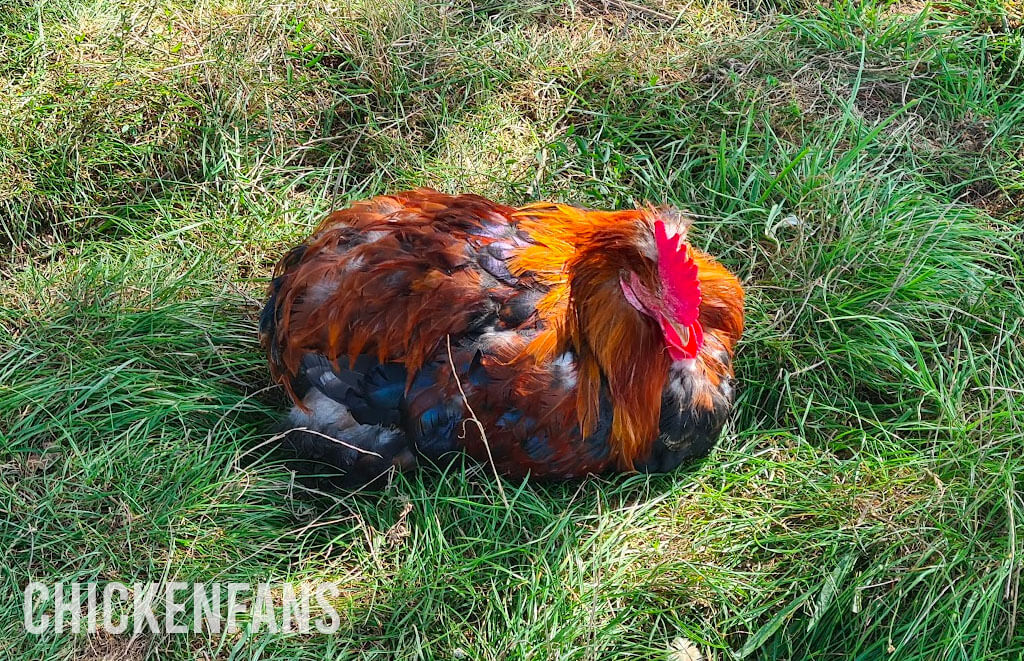
The following table lists all causes of lethargy in chickens, ranging from common to less common.
| Condition | Causes | Commonality | Treatment Method |
| Chronic Respiratory Disease | Bacterial | Common | Antibiotics |
| Heat Stress | Environmental | Common | Provide shade, water, ventilation |
| Intestinal Parasites | Parasitic | Common | Deworming medication (e.g. fenbendazole) |
| Avian Influenza | Viral | Common during outbreaks | Quarantine, supportive care, vaccination |
| External Parasitic Infestation | Parasitic (e.g., mites, lice, red mites) | Common | Use poultry-friendly insecticides |
| Malnutrition | Poor diet or nutrient deficiency | Less common | Improve diet |
| Gastrointestinal Problems | Various (e.g., impacted crop, sour crop) | Common | Crop massage, fluid therapy |
| Injury or Trauma | Physical injuries or accidents | Common | Quarantine and provide first aid |
| Reproductive Problems | Various (egg binding, egg yolk peritonitis) | Common | Contact a vet for first aid |
| Heart Failure | Cardiac issues | Less common | Supportive care, potential medications if prescribed |
| Ascites | Various (genetics, bad hygiene, high protein feed) | Less common | Contact a vet for first aid |
| Atherosclerosis | Accumulation of plaque in arteries | Less common | Improve diet and limit fatty foods |
| Aflatoxicosis | Fungal | Less common | Treat underlying causes, ask for veterinary advice |
| Viral Infections | Various viruses (e.g. Marek’s or Infectious larygotracheitis) | Less common | Vaccination when avialable, supportive care |
1. Chronic Respiratory Disease
As you can see, there is a full spectrum of factors contributing to lethargy in chickens. All should be addressed immediately, or take proactive measures to maintain a healthy flock.
Chronic Respiratory Disease (CRD) is one of the most common bacterial infections in chickens and a significant concern among chicken keepers. The disease can lead to reduced productivity, increased mortality, and decreased overall well-being in your flock.
CRD can be treated with antibiotics, but none will completely remove the bacteria. In most cases, the disease stays dormant in the flock for a lifetime.
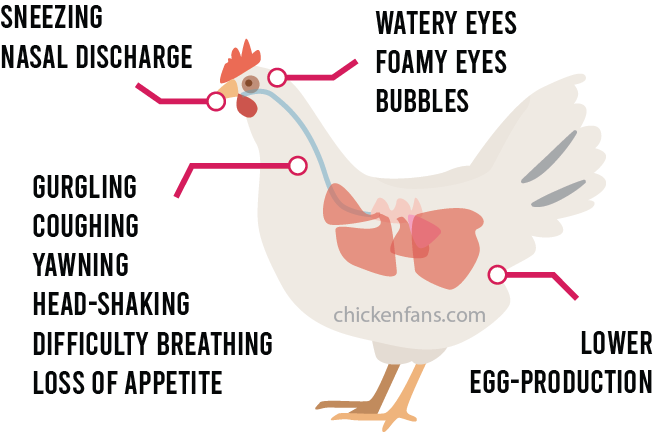
Causes of Chronic Respiratory Disease
Chronic Respiratory Disease in chickens is mainly caused by bacterial infections, with Mycoplasma Gallisepticum and Mycoplasma Synoviae being the primary culprits. These bacteria infect the respiratory tract and lead to inflammation.
Symptoms
Remember that only a veterinarian can make a correct diagnosis of CRD. The most common way to diagnose is by using a real-time PCR test. But we’ll address the most common symptoms of Chronic Respiratory Disease.
- Sneezing, coughing, gurgling sounds
- Head shaking
- Yawning, breathing with open mouth
- Nasal discharge
- Watery, foamy eyes
- Loss of appetite and overall lethargy
- Lower egg production
Diagnosis can be difficult as the symptoms are very similar to other respiratory diseases, such as Infectious Coryza, Infectious Bronchitis, Infectious Laryngotracheitis, Fowl Cholera, Newcastle Disease and others.
Treatment
While prevention is the best approach, there are several things you can do when you suspect CRD in your flock. It’s important to take immediate measures.
- Antibiotics: Consult with a vet to identify the bacteria involved and choose the suited antibiotic treatment. Tetracyclines and macrolides are most commonly used. However, remember that these antibiotics won’t completely remove the bacteria, but they effectively treat symptoms.
- First aid: Isolate the affected chicken(s), consult a vet for proper medication, remove all chickens, and clean and disinfect the coop.
- Supportive care: Provide your flock with a stress-free environment, optimal nutrition, and clean water.
- Monitoring: Regularly monitor your flock’s health and evaluate the treatment progress. If needed, consult your vet to adjust treatment.
It’s important to remember that CRD is challenging to completely eradicate from a flock. A proactive approach that combines prevention, possible vaccination, early detection, and appropriate treatment is crucial.
Consulting with a poultry veterinarian is strongly recommended for an accurate diagnosis of Chronic Respiratory Disease.
2. Heat Stress
Heat stress in chickens is a big concern for chicken keepers during hot and humid weather conditions. Chickens are sensitive to temperature extremes, whether too hot or too cold. The most pleasant temperature for chickens is around 75 degrees Fahrenheit (24°C) or below.
Chickens withstand cold temperatures better than hot ones, and heatwaves will cause discomfort, reduced productivity, and, in severe cases, death.
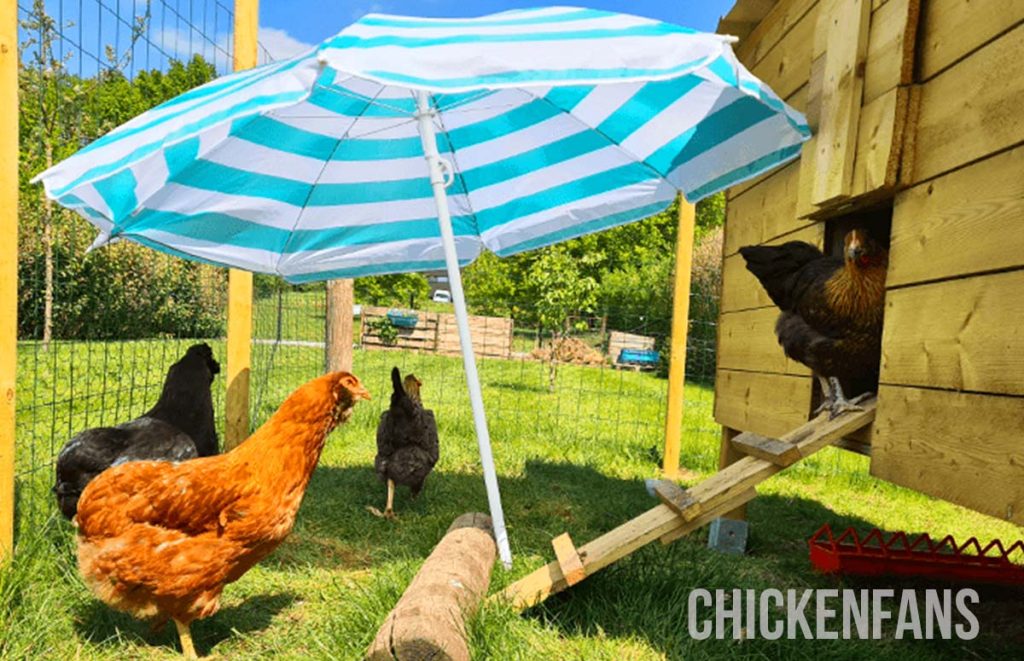
Causes of Heat Stress in Chickens
Heath stress occurs when your chicken’s body temperature rises above normal. A chicken’s normal body temperature is around 104-107°F (41-42°C), and a body temperature of 114°F (46°C) can be deadly for a chicken.
Several factors contribute to heat stress:
- High temperature: Exposure to high ambient temperatures, especially during heatwaves, is a primary cause of heat stress.
- High humidity: Next to high temperatures, high humidity levels impair a chicken’s ability to cool itself. The humidity level inside the coop or barn should never exceed 50%.
- Inadequate ventilation: Poor ventilation in chicken coops will trap heat and humidity.
- Overcrowding: This condition may lead to increased body heat production and reduce air circulation.
- Lack of shade and water: The absence of shade and water will lead to overheating during hot weather.
Symptoms
The symptoms of heat stress can vary, but often include:
- Panting and rapid breathing
- Reduced activity and listlessness
- Fluffed up wings
- Pale comb and wattles
- Increased thirst
- Reduced egg production
Panting, rapid breathing, and fluffed-up wings are the most common signs of heat stress in chickens. It means they’re hot and need to cool down, but there is no need to be alarmed immediately.
Although panting helps them regulate their body temperature, studies show it negatively impacts egg production and egg quality.
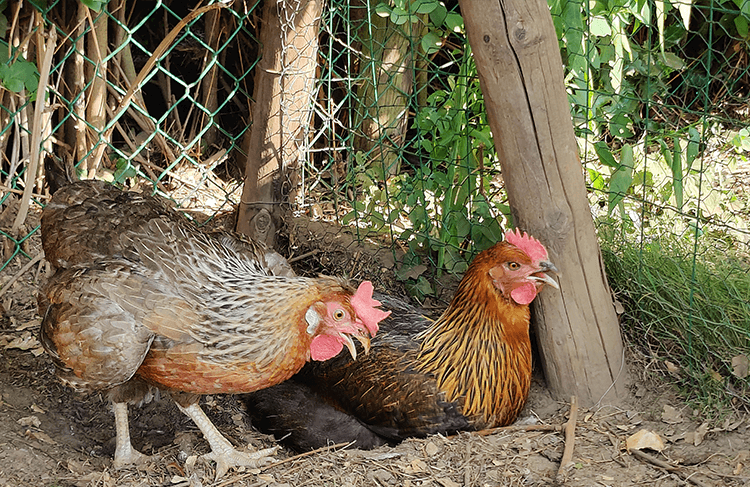
Treatment and Prevention
Proactive measures are essential to mitigate the effects of heat stress in chickens. Once you notice severe heat stress in your flock, taking immediate action is vital.
- Provide shade: Ensure your flock can access shaded areas when the temperature rises above 75 degrees F (24°C).
- Fresh water: Provide a constant supply of fresh, cool water for your chickens to drink. Adding electrolytes to the water during heatwaves can help replenish lost minerals.
- Ventilation: Improve ventilation inside the coop to promote air circulation.
- Dust baths: Provide dust baths in a shady part of the run. As an extra, you can make the sand a bit wet in the morning so they can keep cool by kicking wet dirt on their feathers and skin.
- Wet the run or vegetation above the run: You can create your own ‘airconditioned’ chicken run by using the ground and surrounding vegetation as a natural barrier and moistening them.
Avoid using a hose to spray your chickens or providing them with a kiddy pool. Chickens tend to avoid water; spraying them with a hose will cause stress instead of cooling relief. Furthermore, they will avoid wading through water, so a pool can instantly become unsanitary.
3. Intestinal Parasites
Intestinal parasites can cause lethargy in chickens, affecting their health and productivity. These parasites can compromise the chicken’s digestive system and lead to various symptoms.
The most common examples in chickens of intestinal parasites are:
- Coccidia: Prozoton parasites causing Coccidiosis, which affects the intestinal lining of chickens. This is a common cause of illness in poultry, especially in young chicks.
- Worms: Several types of worms can infect chickens with specific symptoms and causes. For example, roundworms and tapeworms can cause diarrhea, while gapeworms provoke respiratory issues.
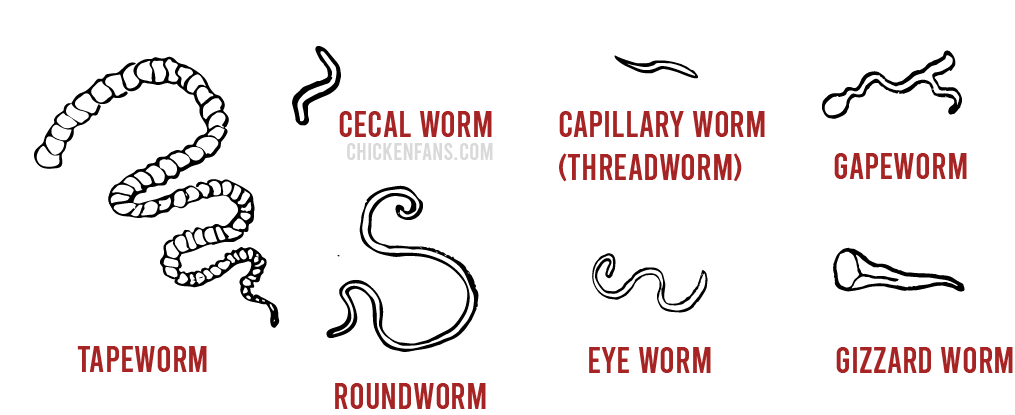
Causes of Intestinal Parasites in Chickens
Intestinal parasites in chickens are often introduced by various means. Whether it’s worms or parasites causing Cocci, they both have several causes and contributing factors.
We’ll address the possible causes by separating the intestinal parasites into coccidia and worms.
Coccidia
Coccidia is the parasite responsible for Coccidiosis, a highly contagious intestinal disease in poultry, including in chickens. These parasites infect the lining of the chicken’s intestine, leading to a range of health issues, including bloody diarrhea.
The primary causes of cocci are:
- Contaminated environment
- Carrier birds
- Stress
- Poor hygiene
Worms
Worms, specifically gastrointestinal worms, can infest chickens and lead to health problems. The primary causes of worm infestation are:
- Contaminated environment
- Free-range grazing
- Contaminated feed and water
- Carrier birds
- Overcrowding
- Lack of deworming
Common types of gastrointestinal worms in chickens are roundworms, tapeworms, and cecal worms.
Symptoms
Next to lethargy, various symptoms arise from parasitic infestations. Understanding these symptoms is crucial for timely intervention and maintaining the well-being of your flock.
The symptoms of intestinal parasites include:
- Lethargy/depression
- Diarrhea
- Weight loss
- Reduced egg production
- Pale comb and wattles
- In case of worms: worms in droppings
- In case of Cocci: bloody diarrhea
Treatment and Prevention
The most effective treatment of intestinal parasites in chickens typically involves dewormers or anticoccidial drugs. Let’s address some general guidelines per common type of intestinal parasite.
Coccidiosis
The most common therapy for coccidiosis involves using Amprolium, best known as “Corid.” Amprolium is a chemical compound designed to imitate vitamin B1 (thiamin) in its function, impeding the parasite’s ability to create carbohydrates essential for replication. This ultimately led to its demise.
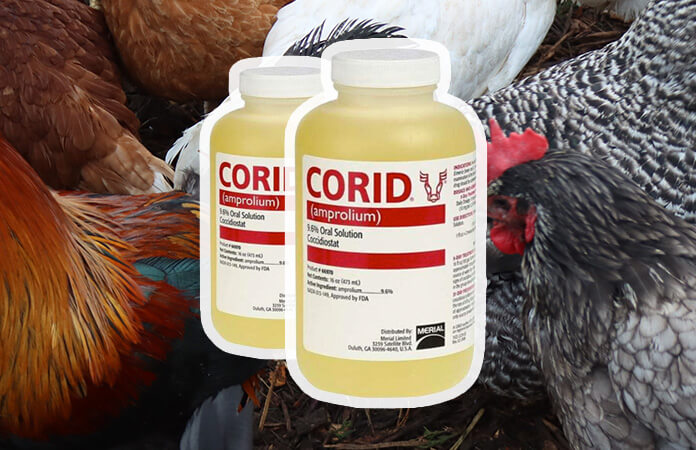
This active ingredient, Amprolium, is available over the counter in many countries, albeit sold under various brand names, with “Corid” being widely recognized.
To know the correct dosage of Corid as a treatment or preventative method against Coccidiosis, please consult our in-depth article on ‘Corid for Chickens: Dosage and Treatment of Coccidiosis‘.
Worms
Ivermectin is probably the most common and well-known dewormer. It’s a broad-spectrum antiparasitic drug that can treat most chicken worms and parasites.
Many veterinarians use it since it’s so effective, although it’s not officially approved for use in poultry. All it takes is a couple of drops on the back of the neck.
The only drawback is that it’s not effective against tapeworms. For full details and instructions, we have a full article on the use of Ivermectin for chickens.
It’s important to note that prevention is more effective than treatment regarding intestinal parasites. Regularly monitoring the flock’s health, maintaining good hygiene, and consulting with a veterinarian for guidance on deworming or using Amprolium are essential to keep chickens healthy.
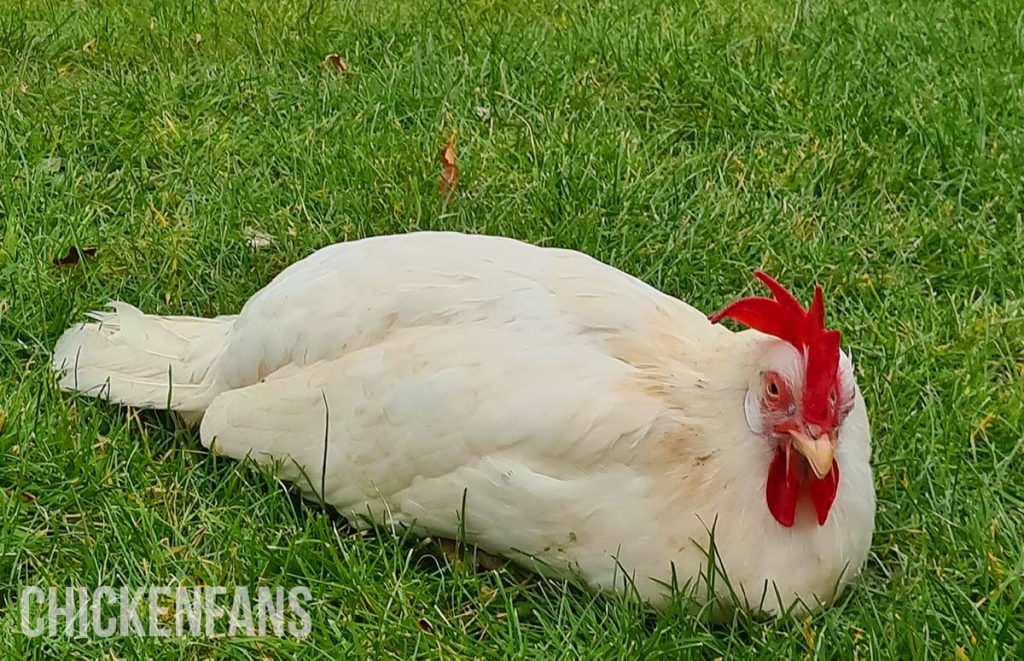
4. Avian Influenza
Avian Influenza, often called bird flu, is a highly contagious viral disease primarily affecting birds, including chickens. While some strains of avian influenza have a low impact on poultry, others are highly pathogenic and cause severe outbreaks.
Causes of Avian Influenza in Chickens
Avian Influenza is caused by various influenza A viruses that primarily affect birds, including chickens. These viruses can be classified into low pathogenic avian influenza (LPAI) and highly pathogenic avian influenza (HPAI), based on the severity of the disease they cause.
Transmission of the virus happens through direct contact with infected birds, contaminated surfaces, or exposure to respiratory discharge and feces. It takes just one contact with the virus to sicken or kill your birds.
Symptoms
The symptoms of Avian Influenza may vary depending on the strain of the virus. It can also differ depending on the bird’s age and overall health.
Common symptoms include:
- Respiratory issues: including sneezing, coughing, nasal discharge, and difficulty breathing.
- Digestive problems: Chickens may have diarrhea and a drop in egg production.
- Neurological symptoms: leading to trembling paralysis or a twisted neck.
- Swelling: swelling of the head, neck, and eyes.
- Sudden death: in severe cases, chickens die suddenly without showing symptoms.
Treatment and Prevention
There is no specific treatment for avian influenza in chickens. Sick birds should be separated from the rest of the flock to prevent further spread of the virus. In the case of an outbreak, affected flocks are mostly culled to prevent the spread of the disease.
Always inform your local health department when suspecting a case of Avian Influenza in your flock.
Prevention is better than cure; therefore, practicing these preventative measures in and around your chicken coop is key:
- Practice biosecurity: Avoid Avian Influenza from entering the premises by practicing good hygiene and biosecurity. This includes controlling access to your coop, disinfecting equipment, and changing clothes and footwear before entering the run.
- Wild bird control: Minimize contact between wild birds or migratory waterfowl and your flock, as they may carry the virus.
- Restrict visitors: Prevent visitors from having contact with your flock.
- Proper waste disposal: Safely dispose of carcasses of infected birds to prevent further outbreaks.
5. External Parasitic Infestation
External parasitic infestations in chickens can lead to discomfort, severe health conditions, listlessness, reduced egg production, and even death. Common examples of external parasites are red mites, lice, and northern fowl mites.
Eradicating these ectoparasites is time-consuming, so preventing them is always better than cure.
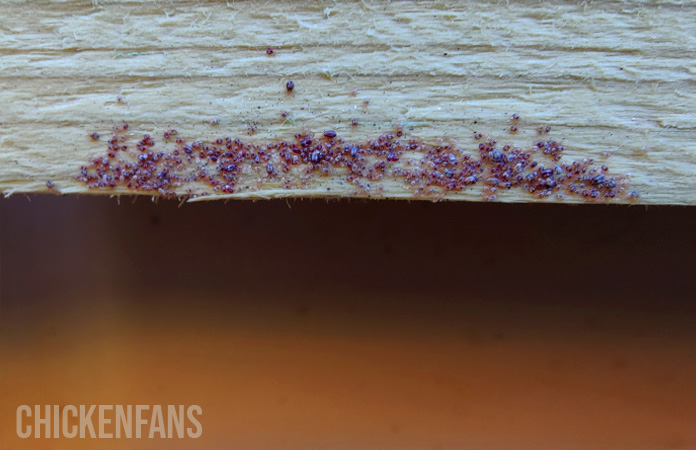
Because of the constant blood loss, your chickens experience sleep deprivation, impacting their quality of life. Chronic fatigue affects their immune system and makes them seem depressed or lethargic.
Causes of External Parasites
The primary causes of external parasites like mites and lice are environmental factors, but they quickly spread from bird to bird. Let’s address some contributing factors:
- Contact with infected birds
- Contaminated coop and/or bedding
- Environmental factors
- Poor hygiene practices
- Contact with wild birds or rodents
To prevent external parasites from entering the coop, it’s essential to clean it regularly, frequently monitor for signs of infestation, and practice good management practices.
Symptoms
Ectoparasites such as red mites, lice, and northern fowl mites have some symptoms in common when they infest chickens. These symptoms generally include:
- Restlessness: Infected chickens may become agitated and restless. Frequently preening or picking their feathers in an attempt to alleviate discomfort.
- Feather loss: Ectoparasites often target feathers or the skin area around the feathers. This leads to feather loss or damage in affected areas.
- Reduced egg production: Chronic infestations lead to a decrease in egg production due to stress and overall discomfort.
- Blood loss: Anemia is not a direct symptom, but severe red mite infestations, for example, will lead to blood loss and eventually death.
In an external parasite infestation it’s important to note that symptoms will vary depending on the extent of the infestations and the type of ectoparasite involved.
Early detection and immediate treatment are essential to alleviate discomfort in your flock.
Treatment and Prevention
Although there are many specific treatment therapies per type of ectoparasite, many general approaches apply to most external parasites.
- Quarantine: Isolate new birds before introducing them into the flock. This prevents the potential danger of bringing ectoparasites together with newcomers.
- Close monitoring: Monitor the flock for any signs of infestation, feather damage, or visible parasites.
- Regular cleaning: Maintain a dry and clean coop and ensure proper ventilation.
- Provide dust baths: Chickens are less likely to catch parasites when they can keep themselves clean in a dust bath.
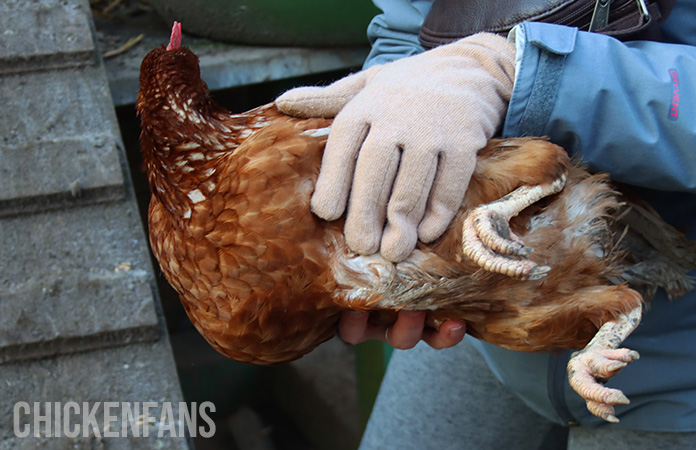
Common Treatment Methods for Red Mites
- Disinfect and/or burn the mites
- Make a Permethrin solution and spray on the coop surface, perches, cracks, and crevices…
Common Treatment Methods for Lice
- Use Ivermectin drops externally to each bird and repeat after 14 days.
- Pyrethrin 1% sprays are also effective against those ectoparasites like lice.
Common Treatment Method for Northern Fowl Mites
- Use Pyrethrin 1%-based products labeled explicitly for poultry
Always follow the instructions on the product labels or consult a veterinarian when in doubt about dosage or use.
6. Malnutrition
Malnutrition in chickens will lead to various health issues, including lethargy, a common symptom of nutritional deficiency. Malnutrition is often noticed in rescued laying hens, ex-battery hens, or older chickens with other nutritional needs.
Causes of Malnutrition
- Inadequate diet
- Poor quality of feed
- Insufficient access to food
A nutritional deficiency in chickens can manifest in different forms, including protein, energy, vitamin or mineral deficiency, or calcium shortage for laying hens.
Symptoms
Lethargy in chickens due to malnutrition can manifest in several ways and has multiple symptoms.
- Reduced activity
- Weakness
- Poor growth
- Feather problems
- Reduced egg production
Treatment or Prevention
The treatment of malnutrition involves addressing the underlying nutritional deficiencies.
- Balanced diet: Provide a balanced and nutritionally complete diet that meets the needs of your chickens based on their age, health, breed, and purpose (laying, meat, rooster).
- Supplements: If you suspect specific deficiencies, consider adding supplements to their diet such as vitamins, minerals or proteins.
- Feed access: Ensure all chickens have access to feed and fresh water at all times. Keep an extra eye out for bullying.
- Monitor and adjust: Check your flock’s health, growth and egg production and adjust their feed if needed.
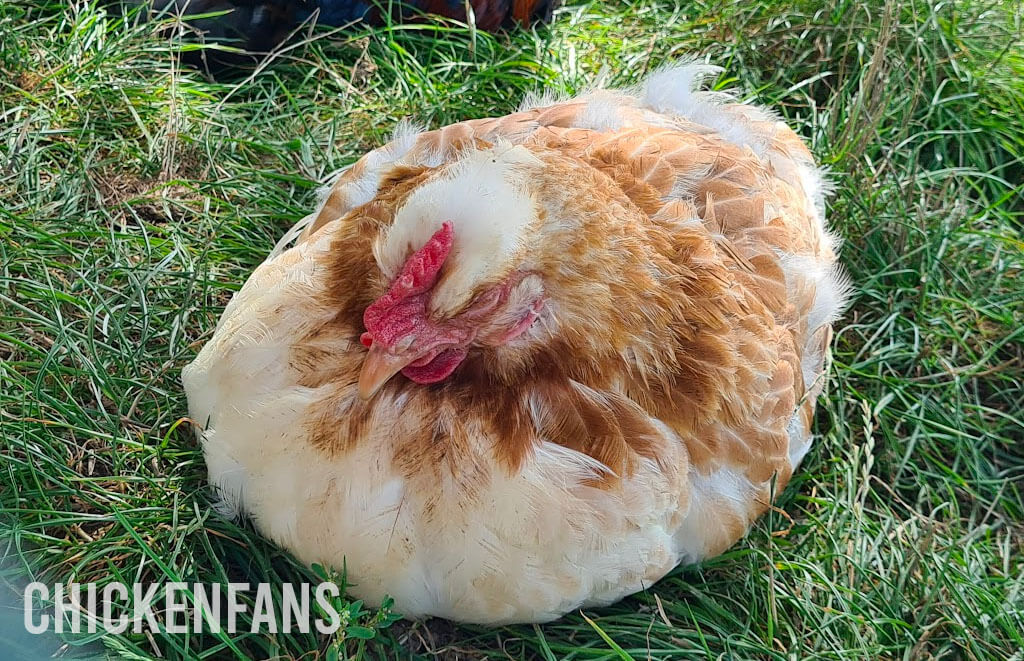
7. Gastrointestinal Problems
Gastrointestinal problems lead to lethargy in chickens, affecting your flock’s overall health and vitality. Various gastrointestinal issues can cause lethargy in chickens, including sour crop, and impacted crop.
Sour Crop
Sour Crop in chickens, or candidiasis, is a yeast infection of the chicken’s crop caused by Candida overgrowth. The responsible Candida fungus occurs naturally in the chicken’s microflora but can grow out of control due to several factors.
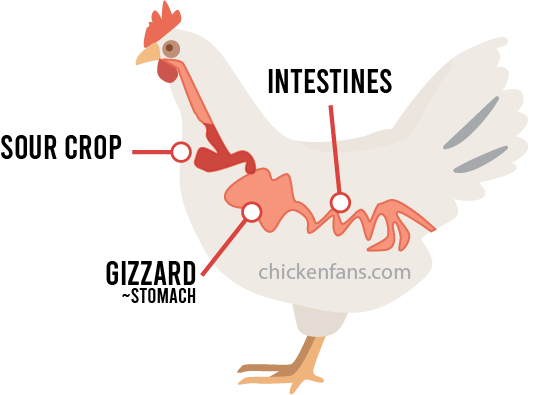
A veterinarian can make a correct diagnosis by microscopic examination of the fungus. It can be challenging to recognize sour crop in chickens from the outside. The most characteristic symptom is the development of white patches inside a chicken’s crop, mouth, and vent area.
Impacted Crop
Another name for impacted crop is crop impaction or crop binding. It is a partial or complete blockage of a chicken’s crop that results in food getting stuck. The crop can’t be emptied overnight and still feels hard in the morning.
Since food remains in the crop for a prolonged time, it’s a perfect breeding ground for the Candida yeast to multiply. That’s why impacted crop is a common precursor of sour crop.
Symptoms of Gastrointestinal Problems
While sour crop and impacted crop are different conditions, their symptoms can look alike. Let’s address their common symptoms and specify which symptoms are exclusive to one condition.
- Lethargy and overall depression
- Loss of appetite
- Regurgitate partially digested food
- Diarrhea or constipation
- Weight loss
Specific Symptoms for Sour Crop
- White patches in the mouth, throat, or vent area
- A foul smell from the mouth
- Difficulty breathing or yawning
Specific Symptoms for Impacted Crop
- Enlarged crop
- Crop doesn’t empty overnight
Treatment of Gastrointestinal Problems
In treatment method, we make a difference in sour crop problems and impacted crop.
Treating Sour Crop Infections
To treat mild cases of sour crop, add apple cider vinegar supplementation to the drinking water to tackle yeast infection. You can also add probiotics to the mix. Pomegranate powder supplementation also has an inhibitory effect on Candida.
Antifungal medication is effective in progressed infections treating sour crop. Usually, the primary treatment takes about a week, with follow-up medication spanning multiple weeks. In all cases, proper hygiene and biosecurity are vital elements for successful recovery.
In severe cases where the crop is completely blocked, a veterinarian must flush it to empty it. This is a risky procedure, so contact a poultry veterinarian to help.
Treatment of Impacted Crop
To treat impacted crop in chickens, identify the issue by feeling for an enlarged crop in the morning. Isolate the affected bird to provide special care.
Gently massage the crop downward to break up the blockage, being cautious not to apply too much pressure. Encourage the chicken to drink water to help soften the contents and aid digestion. Using a small amount of oil, such as olive or vegetable oil, can also help lubricate and soften the contents.
Continuously monitor the chicken’s progress, and if the problem persists, consult a poultry veterinarian for help.
8. Injury or Trauma
Chickens are vulnerable to all kinds of injuries, including falls or accidents, predator attacks, pecking of other flock members, foot injuries, or rough human handling. These traumas can cause an overall listlessness in chickens, at least until complete recovery.
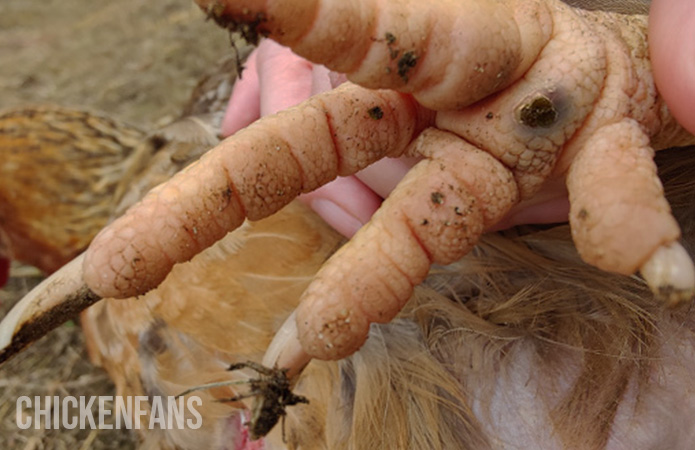
Common injuries in chickens include the following:
- Foot problems: As chickens scratch the soil, they can easily hurt themselves, resulting in cut marks, open wounds, or even bumblefoot.
- Predator attacks: Chickens are prey animals, and a predator attack is not uncommon. This may result in wounds, punctures, broken bones, or death.
- Aggressive behavior: Aggressiveness among chickens to establish the pecking order can lead to injuries, feather damage, open wounds, or death.
- Falls or accidents: Jumping of a high roost, falling out of a tree, or other accidents can always happen when keeping chickens. This may cause limping or wounds.
Symptoms of Injury or Trauma
Chickens experiencing an injury will display a variety of symptoms, depending on the nature of the injury. Examine your chickens when noticing any of the following symptoms.
- Lethargy: Injured chickens, or a flock that has been attacked by a predator, will appear weak, scared, and unwilling to move around in the run.
- Visible wounds: If your chicken is bleeding, or shows bruises or visible wounds, it has become injured.
- Limping: Injuries to the leg or feet can result in limping.
- Fluffed or ruffled feathers: Chickens that are in pain will often fluff up their feathers, attempting to safe energy and stay warm during colder weather.
- Decrease in appetite: Hurt chickens often have a loss in appetite.
Treatment
Injury or trauma in chickens can vary in severity, and the treatment method should always be tailored to the specific situation. Some issues may not be serious, while others need immediate vet advice.
Treatment in trauma may involve the following steps:
- Isolate and examine: Seperate the wounded chicken from the rest of the flock to prevent further harm. Examine it carefully to determine the issue.
- Wound care: Disinfect and clean the wounds with an antiseptic solution. In case of broken bones, seek veterinary advice.
- Pain management: Chickens in pain may benefit from medication such as Paracetamol. Ask your vet for correct use and dosage advice.
- Rest and recovery: Provide a quiet environment for the injured chicken to rest. Ensure access to food and water.
- Monitoring: Continuously monitor the chicken’s recovery and the first weeks after the recovery.
To prevent other and further injuries, assess the coop and run area for hazards and secure it against predators.
9. Reproductive Problems
Reproductive problems in chickens can significantly impact their egg-laying capacity and overall reproductive health. We’ll explore common reproductive issues, causes, symptoms, and potential treatments.
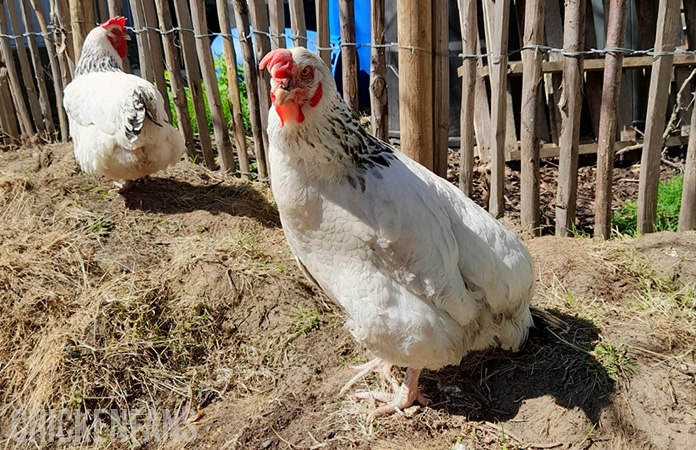
Common examples of reproductive problems are:
- Egg binding: Egg binding occurs when a hen cannot expel an egg from her reproductive tract. The egg is trapped and cannot pass through the cloaca.
- Egg yolk peritonitis: An inflammation of the membrane covering the internal organs caused by the spillage of egg yolk in the body cavity instead of the chicken’s oviduct.
- Low egg production: A decrease in egg production can indicate various reproductive issues.
- Inflammation of the oviduct: Caused by a bacterial infection, this inflammation can cause lash eggs, a serious and contagious condition in chickens.
Causes of Reproductive Problems
- Age
- Obesity
- Poor nutrition
- Stress
- Infections
- Genetic factors
- Broilers or battery-laying hens are more susceptible to reproductive issues
Symptoms of Reproductive Problems
The symptoms of reproductive issues in chickens vary significantly and present differently depending on the specific reproductive issue at hand. Recognizing these signs is crucial for addressing the specific problem you are dealing with.
Symptoms of reproductive issues in chickens include:
- Difficulty laying eggs
- Swollen abdomen
- Decreased activity
- Changes in egg quality
- Penguin stand
- Tail pumping
- Different nesting box behavior
- Constipation or diarrhea
Treatment
- Dietary adjustments: Hens must receive a balanced diet with all nutrients and extra calcium to support egg production
- Isolation: Isolate the affected hen to prevent stress and bullying from other flock members
- Warm bath: For egg binding, placing your chicken in a lukewarm bath may help relax the muscles. It’s worth noting, however, that this treatment rarely works for egg expulsion.
- Antibiotics: In case of infections, antibiotics prescribed by a veterinarian are necessary.
- Surgical intervention: Severe cases of egg binding or egg yolk peritonitis may require surgical drainage or removal of the ovary.
- Culling: In case of severe conditions, euthanasia must be considered to prevent further suffering.
Reproductive issues in chickens are always severe conditions that require immediate veterinary attention. If left untreated, a chicken sometimes dies only 48 hours after diagnosis.
10. Heart Failure
Heart-related problems can have a significant impact on a chicken’s health. These issues can lead to various symptoms, including lethargy. Immediate addressing of cardiac concerns is vital for a speedy recovery.
Possible types of heart failure in chickens include:
- Congestive heart failure: When the heart cannot pump blood effectively, leading to a fluid buildup in the lungs and other tissues.
- Dilated Cardiomyopathy: If the heart’s chambers become enlarged and weakened, unable to pump blood efficiently.
- Sudden Death Syndrome: This term describes sudden and unexplained deaths of apparently healthy chickens and is often associated with heart failure.
Causes of Heart Failure in Chickens
It’s important to acknowledge that some causes of heart failure in chickens are not always preventable. Genetics is a prime example of a non-preventable factor, but regular health monitoring can contribute to the overall well-being of your flock.
Common causes of heart failure in chickens are:
- Genetics
- Nutritional deficiencies
- Infections, such as viral infections
- High blood pressure
Symptoms of Heart Failure
Cardiac conditions are challenging to diagnose because the symptoms can vary widely. Heart-related issues exhibit a range of symptoms, including changes in behavior, breathing, or physical signs of stress.
The most common symptoms of heart failure include
- Difficulty breathing: Shallow, rapid, or labored breathing can be a sign of heart-related issues.
- Lethargy
- Cyanosis: A bluish coloration of the comb and wattles due to reduced oxygen circulation.
- Distended abdomen: Fluid buildup in the abdomen.
- Reduced egg production
Treatment
It’s important to remember that the treatment of heart failure in chickens can be as diverse as the symptoms. The approach to managing cardiac issues can vary depending on the illness, its severity, and the chicken’s health.
- Dietary adjustments: Ensure a diet rich in nutrients, particularly supporting heart health, like antioxidants and omega-3 fatty acids.
- Medication: Consult a veterinarian for medication that may help with heart failure or support heart function.
- Low-stress environment: Minimize stress in and around the chicken coop, avoid overcrowding and keep an eye out for bullying in your flock.
- Euthanasia: In severe cases with no improvement, euthanasia must be considered.
11. Ascites
Water belly or Ascites is a serious condition where a chicken has a squishy, swollen belly full of liquid, as is a notable cause of lethargic chickens. The chicken’s heart can’t cope with its rapid growth, and increased blood pressure causes fluids to leak into the belly (ascites) and lungs, which can be fatal.
It is a common problem mostly seen in broilers.
The issues begin when the chicken’s heart lacks the strength to support the chicken’s larger body. Given the chicken’s substantial oxygen requirements, this stresses the heart. Furthermore, larger meat chickens have relatively undersized lungs compared to their size, making it harder to breathe.
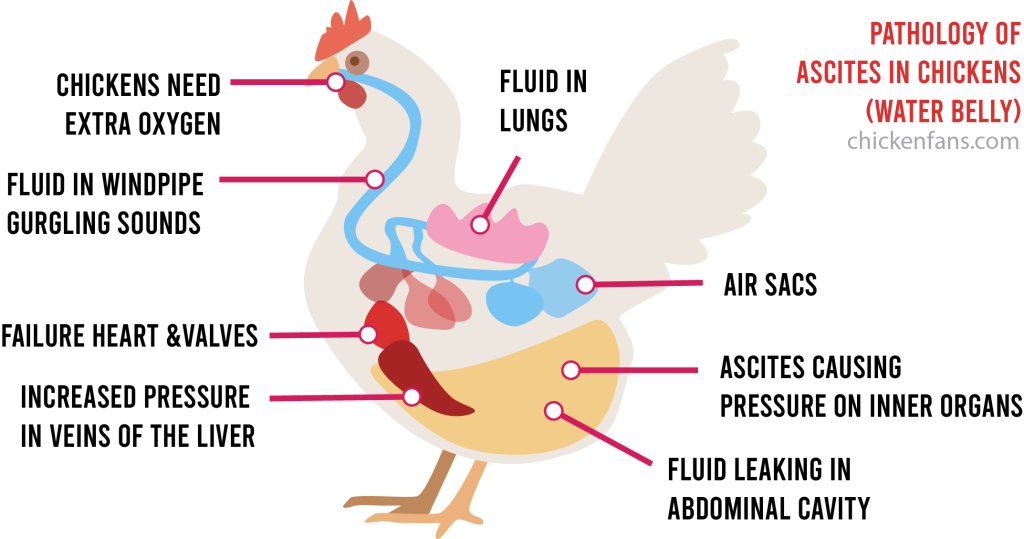
Causes of Ascites
Ascites in chickens can result from underlying causes, often linked to circulatory and respiratory conditions.
Risk factors for ascites:
- Genetics: Selective breeding for bigger muscles and fast growth, broiler breeds.
- Low Oxygen Levels: Heat stress, high altitudes, low air quality, bad ventilation, freezing temperatures.
- High Protein Feed: Feeding type and protein density, growth boosters.
- Environment: Pathogen control and biosecurity practices.
Symptoms
Recognizing the symptoms of Ascites is essential for early intervention. The presentation of these symptoms may vary, but there is one major sign.
Symptoms of water belly in chickens include:
- Distended, swollen belly, squishy and full of liquid
- Difficulty breathing, panting, gurgling sounds, shortness of breath
- Pale, blue, or purple comb
- Red belly skin and missing feathers
- Impaired growth
- Penguin stand
- Lethargy
- Acute death
Treatment
Water belly is first treated by draining the build-up fluid in the belly with a syringe to relieve the pain. However, this will not remove the underlying issue of pulmonary hypertension, and the belly will start swelling again.
The second part of treatment is prevention and control.
- Drain build-up fluid (done by vet)
- Restrict feed intake and proteins
- Switch to pellet food
- Avoid extreme cold and heat
- Lower altitude: anything above 1500m is inappropriate for raising meat chickens
- Treat respiratory diseases
- Get rid of any ground for fungi and bacteria
12. Viral Infections
Viral infections are caused by various pathogens that target the chicken’s immune system, leading to a range of diseases. These infections are contagious and can spread rapidly within flocks. The severity of symptoms and the impact on flock health depend on the specific virus involved.
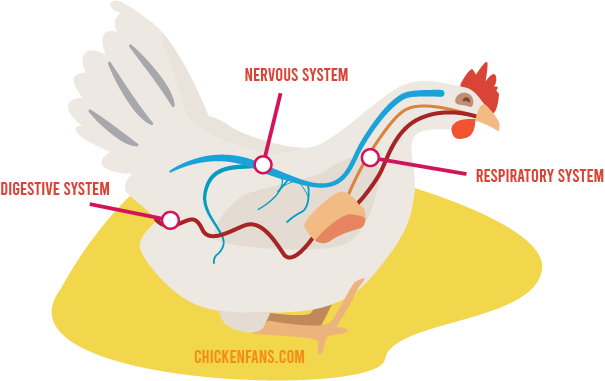
Common types of viral infections in poultry are:
- Avian Influenza: Avian influenza, or bird flu, is one of the infections we saw previously on this list. It is a highly contagious infection that can affect chickens, leading to respiratory and gastrointestinal symptoms.
- Newcastle Disease: Newcastle disease is another highly contagious viral infection that can cause respiratory, digestive, and neurological issues.
- Infectious Bronchitis: This viral respiratory disease affects the respiratory tract, leading to coughing, sneezing, and nasal discharge.
- Marek’s Disease: Marek’s disease is a viral infection that affects the nervous and immune systems, causing various symptoms, including paralysis.
Causes of Viral Infections
The causes of viral infections in chickens involve exposure to infected birds or contaminated environments. These viruses can spread through direct contact, airborne transmission, or contaminated feed and water.
Symptoms
The symptoms of viral infections vary depending on the virus and the age and health of the birds.
Common symptoms include:
- Lethargy: Chickens affected by viral infections appear weak and reluctant to move.
- Respiratory Signs: Coughing, sneezing, nasal discharge, and wheezing.
- Digestive Disturbances: This may include diarrhea, reduced appetite, and weight loss.
- Neurological Signs: In cases like Marek’s disease, chickens exhibit paralysis, muscle wasting, and difficulty walking.
- Reduced Egg Production
Treatment or Prevention
Treatment options for viral infections are limited, as there are no specific antiviral medications available for poultry. Management primarily focuses on supportive care and prevention by vaccination (if possible).
If a viral outbreak occurs, consult with a veterinarian for guidance on containment, prevention, and treatment strategies.
13. Atherosclerosis
Atherosclerosis is a cardiovascular condition that affects chickens, humans, and other animals. It is characterized by the buildup of fatty deposits, cholesterol, cellular waste, and calcium on the walls of arteries.
Over time, these deposits, called plaques, can narrow and harden the arteries, restricting blood flow.
Causes of Atherosclerosis
The causes of Atherosclerosis in chickens are similar to those in humans and include:
- Dietary factors: Diets high in saturated fats, cholesterol, and low in antioxidants contribute to the development of Atherosclerosis.
- Genetics: Some breeds or hybrids are more likely to suffer from Atherosclerosis.
Symptoms
Detecting atherosclerosis in chickens can be challenging, as they do not display symptoms like humans do.
However, some signs may include:
- Reduced activity
- Respiratory distress
- Reduced egg production
Treatment
Managing atherosclerosis in chickens involves several strategies:
- Change of diet
- Medication
- Stress reduction
- Supportive care
- Preventative measures
14. Aflatoxicosis
Aflatoxicosis is a condition that can affect chickens when they consume feed contaminated with aflatoxins. Aflatoxins are naturally occurring mycotoxins produced by molds, such as Aspergillus flavus and Aspergillus parasiticus.
These toxins are potent carcinogens and can have harmful effects on both chickens and human health.
Causes of Aflatoxicosis in Chickens
Aflatoxicosis in chickens primarily occurs due to ingesting feed contaminated with aflatoxins. Several factors can contribute to aflatoxin contamination, including:
- Environmental Conditions: Warm and humid climates create advantageous conditions for the growth of aflatoxin-producing mold.
- Improper Storage: Poor storage, such as insufficient moisture control and ventilation, can promote mold growth and aflatoxin production.
- Crop Contamination: Aflatoxins can originate from mold-infested crops.
Symptoms
Aflatoxicosis can manifest in different ways:
- Reduced feed intake
- Decreased weight gain
- Liver damage
- Reduced egg production
- Immune suppression
Treatment and Prevention
Preventing Aflatoxicosis is essential, as the condition can have significant health implications for poultry flocks. Treatment for Aflatoxicosis in chickens primarily focuses on reducing further exposure to aflatoxins and supporting affected birds:
- Feed management
- Liver support
- Hydratation
- Monitoring
- Preventative measures
Summary
Lethargy in chickens is a sign of underlying health issues. Various factors, including diseases, environmental factors, and nutritional imbalances, can contribute to lethargy. Recognizing this behavior is crucial for early intervention and proper care, as it often indicates a need for further treatment.
Prompt attention to the underlying causes is essential for maintaining the health and well-being of chicken flocks.























